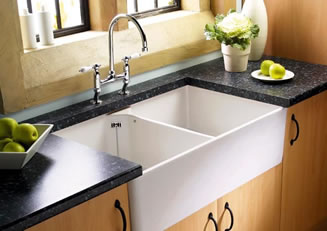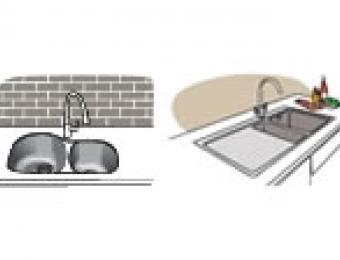
A very popular material when it comes to kitchen sinks, porcelain (also referred to as 'ceramic') is heavy, durable and manufactured in a very wide range of shapes and colours. Porcelain has been used throughout the world for centuries, and is therefore as much at home in more traditional types or regionally-styled kitchens as it is in sleek modern kitchens.
How are porcelain sinks made?
In a nutshell, porcelain's effectively made of kaolin, which is a fine type of silicate-based clay mineral. This is sculpted or moulded to the required shape, covered with a glaze and then fired at an extremely high heat (between 1,200°C and 1,400°C). The firing effectively triggers a physical reaction, and turns the surface of the sink into the tough, shiny glass finish that we all associate with the material.
What are the properties of porcelain sinks?
Porcelain sinks look fantastic, and can be decorated with special patterns and coloured glazes for some striking finishes. Porcelain sinks feel very solid, and are resistant to extreme hot and cold. Because porcelain is effectively glass, though, it can be chipped, scratched or cracked by sharp or heavy objects. Porcelain doesn't deal well with aggressive cleaning either - scrubbing it with an abrasive scourer or similar can easily leave permanent scuffs on the surface of a porcelain sink, which will reduce its lustre and shine.
What are butlers sinks and farmers sinks?
Porcelain sinks are often made with overflow drains or weirs integrated into the design, and can be arranged to suit any configuration you choose. Likewise, they'e available both as top-mount and undermount sinks.
In recent years the porcelain 'Butlers' sink' has come back into fashion. This is a shallow, rectangular-type ceramic sink with a rounded rim, which is set into a work surface.
There are two types of Butler’s sinks: The London Sink and the Belfast Sink. The difference, while very subtle, is that the Belfast version has an overflow channel built into it which prevents water from spilling over the edge. A third variation is the farmers' sink, which is much deeper, and has its front basin wall exposed (and normally finished with a decorative design).
A cost-effective alternative to porcelain (depending on the style you're after) is enamel over cast iron sinks, which are made to look similar to porcelain, but have a cast iron core and are more resistant to damage as a result.
|
Advantages
|
Disadvantages
|




